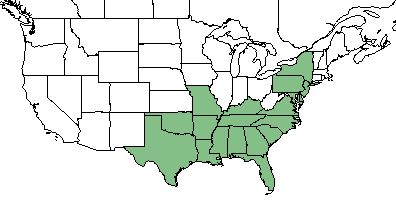Chasmanthium laxum
Common name: Slender Woodoats[1]; Slender Spikegrass[2]
| Chasmanthium laxum | |
|---|---|
Error creating thumbnail: Unable to save thumbnail to destination
| |
| Photo from USDA NRCS Plants Database. | |
| Scientific classification | |
| Kingdom: | Plantae |
| Division: | Magnoliophyta - Flowering plants |
| Class: | Liliopsida - Moncots |
| Order: | Cyperales |
| Family: | Poaceae |
| Genus: | Chasmanthium |
| Species: | C. laxum |
| Binomial name | |
| Chasmanthium laxum (L) Yates | |

| |
| Natural range of Chasmanthium laxum from USDA NRCS Plants Database. | |
Contents
Taxonomic Notes
Synonyms: Uniola laxa (Linnaeus) Britton, Sterns, & Poggenburg[3]
Varieties: none[3]
Description
C. laxum is a perennial grass of the Poaceae family native to North America.[1] The leaves are alternate and simple with parallel venation. The fruit is a caryopsis (dry, one-seeded, with the ovary wall and seed coat attached), and the overall root growth is fibrous.[4]
C. sessiliflorum is mostly morphologically similar to C. laxum and they often grow side by side.[2]
Distribution
C. laxum can be found along the southeastern coast from Texas to New York[1] with disjunct populations in the Eastern Highland Rim and Cumberland Plateau regions of Tennessee and Kentucky.[5]
Ecology
Habitat
C. laxum is listed as a facultative wetland species[1] and can be found in savanna-pocosin ecotones, sandhill-pocosin ecotones, moist hardwood swamps, bottomland hardwood forests, mesic hammocks, and other moist habitats,[2][6] but this species can occur in non-wetland areas such as upland closed-canopy forests where fire is excluded, including slope forest and upland hardwood (beech-magnolia) forest[6], and on disturbed sites such as roadside ditches, low pinewoods, stream banks, in shallow water, and other shaded areas.
Chasmanthium laxum is shade-tolerant, enabling it to thrive under the canopy of other plants[7], and it primarily grows in soils such as sand, sandy loam, loam, and moist loam sand.[8]
Japanese stiltgrass (Microstegium vimineum) has a negative effect on C. laxum and over-competes with the species when the canopy is opened.[9] C. laxum does not respond to soil disturbance by clearcutting and chopping in North Florida flatwoods forests.[10]
Associated species include Pinus elliottii, Chasmanthium nitidum, Chasmanthium latifolium, Chasmanthium ornithorhynchus, Panicum sp., Pterocaulon sp., Vitis rotundifolia, Toxicodendron radicans, Gibasis pellucida, Calopogon tuberosus, Quercus geminata, Quercus nigra, Quercus sp., Liquidambar styraciflua, and others.[8][11]
Phenology
C. laxum has been observed to flower from June to August, and fruit during the same time period.[12][8]
Seed dispersal
This species is thought to be dispersed by gravity.[13]
Fire ecology
C. laxum is not fire resistant and has no fire tolerance. [1]
Herbivory and toxicology
C. laxum is highly palatable to browsing and grazing animals, including tame deer and cattle.[1][14] It consists of approximately 2-5% of the diet for large mammals and terrestrial birds.[15]
Conservation, cultivation, and restoration
C. laxum is listed as an endangered species by the New York Department of Environmental Conservation Division of Land and Forests, and the Pennsylvania Department of Conservation and Natural Resources. [1]
Cultural use
Photo Gallery
References and notes
- ↑ 1.0 1.1 1.2 1.3 1.4 1.5 1.6 USDA Plant Database https://plants.usda.gov/core/profile?symbol=CHLA6
- ↑ 2.0 2.1 2.2 Weakley, A. S. (2015). Flora of the Southern and Mid-Atlantic States. Chapel Hill, NC, University of North Carolina Herbarium.
- ↑ 3.0 3.1 Weakley, A.S. 2020. Flora of the Southeastern United States. Edition of 20 October 2020. University of North Carolina at Chapel Hill, Chapel Hill, North Carolina.
- ↑ [[1]] Lady Bird Johnson Wildflower Center. Accessed: April 5, 2019
- ↑ Sorrie, B. A. and A. S. Weakley 2001. Coastal Plain valcular plant endemics: Phytogeographic patterns. Castanea 66: 50-82.
- ↑ 6.0 6.1 Florida Natural Areas Inventory 2010. Guide to the natural communities of Florida: 2010 edition. Florida Natural Areas Inventory, Tallahassee, Florida, 228 pg.
- ↑ Iglay, R. B., et al. (2010). "Effect of plant community composition on plant response to fire and herbicide treatments." Forest Ecology and Management 260: 543-548.
- ↑ 8.0 8.1 8.2 Florida State University Robert K. Godfrey Herbarium database. URL: http://herbarium.bio.fsu.edu. Last accessed: March 2019. Collectors: Loran C. Anderson, A. F. Clewell, S. T. Cooper, M. Darst, R. F. Doren, R.K. Godfrey, J. Good, B. F. Hansen, J. M. Kane, Herbert Kessler, Tina Kessler, R. Komarek, Mabel Kral, R. Kral, - Kurz, H. Light, G. Mahon, D. L. Martin, R. Mattson, Sidney McDaniel, Robert A. Norris, R. E. Perdue, Paul Redfearn, Jr., George Robinson, Cecil Slaughter, and J. N. Triplett, Jr. States and Counties: Florida: Alachua, Baker, Clay, Escambia, Franklin, Gadsden, Gulf, Hernando, Holmes, Jefferson, Leon, Levy, Marion, Okaloosa, St Johns, Taylor, Wakulla, and Walton. Georgia: Atkinson, Grady, and Thomas.
- ↑ Brewer, S. J., et al. (2012). "Do natural disturbances or the forestry practices that follow them convert forests to early-successional communities?" Ecological Applications 22: 442-458.
- ↑ Moore, W.H., B.F. Swindel, and W.S. Terry. (1982). Vegetative Response to Clearcutting and Chopping in a North Florida Flatwoods Forest. Journal of Range Management 35(2):214-218.
- ↑ Morris, M. W. (1988). "Noteworthy vascular plants from Grenada County, Mississippi." SIDA Contributions to Botany 13(2): 177-186.
- ↑ Nelson, G. PanFlora: Plant data for the eastern United States with emphasis on the Southeastern Coastal Plains, Florida, and the Florida Panhandle. www.gilnelson.com/PanFlora/ Accessed: 18 MAY 2018
- ↑ Creech, M. N., et al. (2012). "Alteration and Recovery of Slash Pile Burn Sites in the Restoration of a Fire-Maintained Ecosystem." Restoration Ecology 20(4): 505-516.
- ↑ Thill, R. E. (1984). "Deer and cattle diets on Louisiana pine-hardwood sites." The Journal of Wildlife Management 48(3): 788-798.
- ↑ Miller, J.H., and K.V. Miller. 1999. Forest plants of the southeast and their wildlife uses. Southern Weed Science Society.